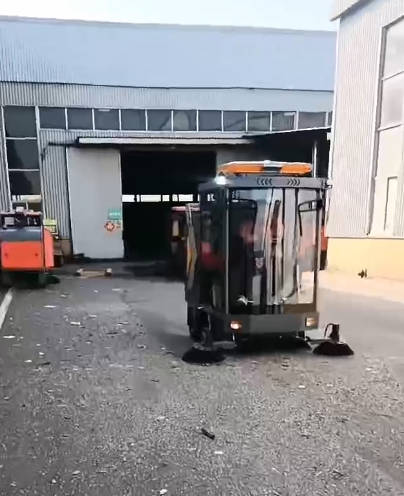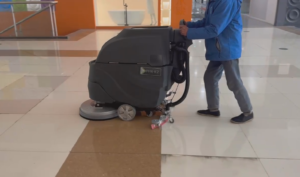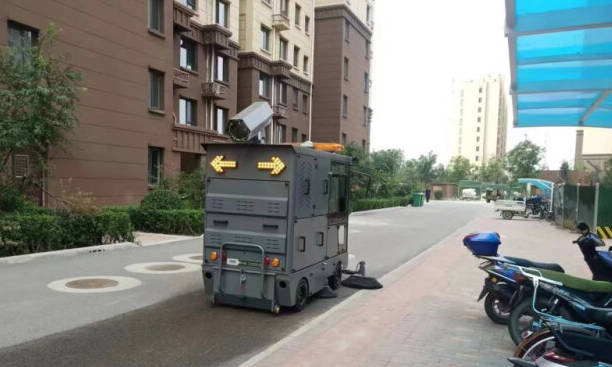Introduction
Dirty, slippery floors in malls and retail stores don’t just look bad—they’re a safety hazard and a maintenance nightmare. High-traffic areas demand robust cleaning solutions to stay durable and slip-free under constant foot traffic.
That’s where high-traffic floor cleaners like advanced sweepers and scrubbers shine. Combined with smart scheduling and staff training, these tools ensure clean, safe floors. This guide shares best practices to optimize your cleaning operations and protect your business.
Why High-Traffic Floors Need Specialized Cleaning Solutions
High-traffic floors in places like malls, airports, and retail stores face unique challenges. Heavy foot traffic brings dirt, grime, and wear that regular cleaning can’t handle. To keep these floors safe and looking good, you need a high-traffic floor cleaner designed for tough jobs.
Common Challenges: Dirt Buildup, Wear, and Slip Hazards
High-traffic floors collect dirt fast. Shoes track in mud, spills happen, and dust settles, creating a messy buildup. Over time, this grime causes wear, scratches, and even slip hazards that can lead to accidents. A standard mop and bucket won’t cut it when you’re dealing with thousands of footsteps daily.
Slip hazards are a big deal in commercial spaces. According to the National Floor Safety Institute, slips and falls cause over 1 million emergency room visits yearly in the U.S. Proper commercial floor cleaning reduces these risks, keeping customers and staff safe.
Importance of Durable Cleaning for Aesthetic and Safety Standards
A clean floor isn’t just about looks—it’s about safety and reputation. Scuffed, dirty floors make a business look unprofessional, driving customers away. Durable cleaning solutions, like heavy-duty scrubbers, maintain that polished look while meeting safety standards.
Regular cleaning also extends the life of flooring materials. Tiles, vinyl, or hardwood in high-traffic areas can degrade without proper care. Using the best cleaning products for high-traffic floors protects your investment and keeps spaces inviting.
Role of Heavy-Duty Cleaners in High-Traffic Environments
Heavy-duty cleaners, like the PHR-X2 Scrubber from Pohir Group, are built for high-traffic challenges. These machines scrub, dry, and polish floors in one pass, saving time and effort. CE-certified equipment ensures safety and reliability, making it ideal for busy environments.
Unlike manual methods, automated scrubbers handle large areas quickly. They use powerful brushes and eco-friendly detergents to tackle stubborn dirt. This efficiency is a “game-changer” for facility managers juggling tight schedules.
Industry Demands for Efficient Cleaning in Malls and Retail
Malls and retail stores need cleaning solutions that work fast and don’t disrupt business. Shoppers expect spotless floors, and downtime for cleaning can hurt sales. Efficient high-traffic floor maintenance keeps operations smooth and customers happy.
Beyond equipment, staff training and smart scheduling are key. Well-trained teams know how to use scrubbers effectively, and cleaning during off-peak hours minimizes disruptions. This combo of tech and strategy boosts overall efficiency.
Specialized cleaning solutions, like heavy-duty scrubbers and trained staff, keep high-traffic floors safe, durable, and visually appealing.
High-Traffic Floor Cleaning Equipment Comparison
| Feature | Manual Mop | Walk-Behind Scrubber | Ride-On Scrubber | Industry Benchmark |
|---|---|---|---|---|
| Cleaning Speed (sq ft/hr) | 2,000 | 20,000 | 50,000 | 30,000 |
| Labor Hours (per 10,000 sq ft) | 5 | 0.5 | 0.2 | 0.3 |
| Water Usage (gallons) | 10 | 5 | 8 | 6 |
| Safety Certification | None | CE Certified | CE Certified | CE Certified |
| Maintenance Cost (annual) | $100 | $500 | $800 | $600 |

Selecting the Right Equipment for High-Traffic Floor Cleaning
Choosing the right equipment for high-traffic floor cleaner needs is critical for facility managers. Busy commercial spaces like malls and airports demand machines that can handle heavy dirt and wear while keeping floors safe and shiny. This chapter guides you through selecting durable, efficient cleaning equipment to tackle cleaning busy floors. Let’s dive into the options and features that make a difference.
Types of Equipment: Sweepers, Scrubbers, and Combination Machines
Sweepers are great for picking up dry debris like dust or small particles. Scrubbers, on the other hand, use water and brushes to deep-clean sticky or greasy floors. Combination machines do both, offering versatility for large spaces. Picking the right type depends on your floor’s needs and traffic levels.
For example, a mall with food courts might need a scrubber for spills, while a warehouse might lean toward a sweeper. Understanding your space helps you choose wisely. Pohir Group’s range, like the PHR-xs60 scrubbering&sweeping machine, is built for heavy-duty tasks.
Key Features to Look For: Power, Battery Life, and Surface Compatibility
When selecting equipment, focus on power, battery life, and surface compatibility. Powerful motors handle tough grime, while long battery life ensures uninterrupted cleaning in big spaces. Surface compatibility matters too—some machines work better on tile, others on concrete.
Look for machines with adjustable settings to match different floor types. A high-traffic floor cleaner like Pohir’s PHR-1280 offers strong battery life and works on multiple surfaces, making it a solid pick for facility cleaning management.
Benefits of CE-Certified Machines for Commercial Use
CE-certified machines meet strict safety and quality standards, which is crucial for commercial spaces. They reduce risks like electrical faults or chemical leaks, protecting staff and customers. Plus, certified equipment often lasts longer, saving money over time.
Pohir Group’s CE-certified machines, including scrubbers and sweepers, are designed for reliability. Their supply chain ensures you get equipment when you need it, keeping your cleaning schedule on track. This reliability is key for busy environments.
Case Study: Pohir Group’s PHR-1280 Sweeper for Large-Scale Cleaning
The PHR-1280 Sweeper is a beast for large-scale cleaning. Used in a major retail chain, it cut cleaning time by 40% compared to manual methods. Its wide cleaning path and dust control system make it perfect for how to clean busy commercial floors safely.
What sets it apart is its ease of use. Staff learned to operate it in hours, thanks to Pohir’s training support. Pairing equipment with proper training is a “no-brainer” for boosting efficiency in high-traffic areas.
Choosing a CE-certified high-traffic floor cleaner with strong power and staff training ensures safe, efficient cleaning in busy commercial spaces.
Best Practices for Slip-Resistant and Durable Floor Maintenance
Maintaining slip-resistant and durable floors in high-traffic areas like malls or offices is no small feat. Heavy foot traffic brings dirt, wear, and safety risks that demand smart strategies. Using the right high-traffic floor cleaner, sealants, and maintenance plans can keep floors safe and long-lasting. This chapter shares practical tips to boost floor safety in commercial spaces.
Choosing Non-Slip, Fast-Drying Cleaning Solutions
Non-slip cleaning solutions are a must for busy floors. These products reduce slippery residues, lowering the risk of falls. Fast-drying formulas, like those from Pohir Group, ensure floors are ready for traffic sooner, minimizing disruptions.
Look for best cleaning products for high-traffic floors with anti-slip additives. They clean effectively while adding grip. Pairing these with scrubbers enhances results, keeping floors spotless and safe.
Applying Protective Sealants to Extend Floor Lifespan
Protective sealants act like a shield for floors. They guard against scratches, stains, and wear, especially in high-traffic zones. Applying sealants every 6-12 months can double the lifespan of materials like vinyl or tile.
Choose sealants compatible with your floor type. For example, polyurethane works well on hardwood, while epoxy suits concrete. Regular sealing as part of high-traffic floor maintenance saves money on repairs down the road.
Regular Maintenance Schedules to Prevent Wear and Tear
Consistency is key to durable floors. A regular maintenance schedule—daily sweeping, weekly scrubbing, and monthly inspections—prevents dirt buildup and catches issues early. Scheduling cleaning during off-hours keeps businesses running smoothly.
Staff training is a “must-have” for success. Well-trained teams use equipment efficiently and spot wear before it worsens. Pohir Group’s support includes training guides to optimize cleaning routines.
Safety Certifications and Compliance for Commercial Spaces
Safety certifications, like CE markings, ensure cleaning products and equipment meet strict standards. This is critical for commercial spaces where liability is a concern. Certified products reduce risks like chemical hazards or equipment failures.
Partnering with trusted suppliers like Pohir Group guarantees access to compliant, high-quality solutions. Their CE-certified scrubbers and cleaners help businesses meet OSHA and ADA requirements, boosting floor safety in commercial spaces.
Using non-slip cleaners, protective sealants, and regular maintenance with certified products keeps high-traffic floors safe and durable.
Floor Maintenance Product Comparison
| Feature | Standard Cleaner | Non-Slip Cleaner | Sealant-Coated | Industry Standard |
|---|---|---|---|---|
| Slip Resistance (COF*) | 0.4 | 0.6 | 0.7 | 0.6 |
| Drying Time (minutes) | 30 | 15 | 60 | 20 |
| Durability (years) | 1 | 2 | 5 | 3 |
| Application Frequency | Daily | Daily | 6-12 months | Annual |
| Safety Certification | None | OSHA Compliant | ADA Compliant | OSHA/ADA |
Note: *COF (Coefficient of Friction) measured per ASTM standards; drying time based on manufacturer data; durability reflects average lifespan under high-traffic conditions.

Optimizing Cleaning Schedules for High-Traffic Areas
High-traffic areas like malls, airports, and retail stores need cleaning schedules that keep floors spotless without disrupting business. A well-planned schedule maximizes efficiency, reduces safety risks, and ensures a welcoming environment. Using tools like a high-traffic floor cleaner, such as Pohir Group’s PHR-X2 Scrubber, makes this easier. This chapter shares strategies for crafting an effective cleaning schedule for high-traffic areas.
Importance of Frequent Cleaning During Peak Hours
Peak hours bring the most dirt and foot traffic, making frequent cleaning essential. Quick spot-cleaning during busy times prevents grime buildup and slip hazards. For example, entryways can get messy fast, so tackling them often keeps floors safe and presentable.
Automated equipment speeds up these tasks. Pohir Group’s scrubbers are designed for quick passes, allowing staff to clean without closing off areas. This keeps commercial floor cleaning seamless, even during rush hours.
Smart Scheduling: Balancing Daily and Deep Cleaning
A smart schedule balances daily touch-ups with periodic deep cleaning. Daily tasks, like sweeping and mopping, handle surface dirt, while weekly or monthly scrubs tackle embedded grime. Planning deep cleans during off-hours minimizes disruptions to customers and staff.
Staff training is crucial for this balance. Well-trained teams know when to switch between light and heavy tasks, boosting efficiency. Pohir Group’s training support helps crews master this, making facility cleaning management a breeze.
Targeting High-Traffic Zones Like Entryways and Corridors
Entryways, corridors, and food courts are cleaning hotspots. These zones face constant traffic, collecting dirt and debris faster than other areas. Prioritizing them in your schedule ensures they stay clean and safe.
Using targeted equipment, like the PHR-X2 Scrubber, helps. Its ergonomic design lets staff focus on tight or busy spots without slowing down. This precision is a “total win” for keeping high-traffic zones in top shape.
Tools for Monitoring and Adjusting Cleaning Frequency
Monitoring tools, like cleaning logs or IoT-enabled machines, track dirt levels and equipment performance. These insights help managers adjust schedules based on real-time needs. For instance, a busier-than-usual day might call for extra cleaning passes.
Pohir Group’s equipment includes features like usage tracking, which helps fine-tune schedules. Combining tech with staff feedback ensures your cleaning plan stays flexible and effective for commercial floor cleaning.
An effective cleaning schedule for high-traffic areas combines frequent spot-cleaning, targeted deep cleans, and smart tools to keep floors safe and efficient.
Cleaning Schedule Efficiency Comparison
| Feature | Ad-Hoc Cleaning | Basic Schedule | Smart Schedule | Industry Standard |
|---|---|---|---|---|
| Daily Cleaning Time (hours) | 8 | 6 | 4 | 5 |
| Deep Clean Frequency | Monthly | Biweekly | Weekly | Biweekly |
| Disruption Level | High | Medium | Low | Low |
| Slip Incident Reduction | 10% | 30% | 50% | 40% |
| Tech Integration | None | Manual Logs | IoT Monitoring | Basic Sensors |
Note: Daily cleaning time based on 10,000 sq ft; disruption level reflects customer impact; slip incident reduction per industry safety reports.

Training Staff for Efficient and Safe Cleaning Operations
Training staff to use advanced cleaning equipment is crucial for maintaining high-traffic floors. Proper training ensures safety, boosts efficiency, and extends equipment life in busy commercial spaces. With a high-traffic floor cleaner like Pohir Group’s PHR-1280 Sweeper, skilled staff can achieve top results. This chapter explores how training enhances durable floor cleaning solutions and safety.
Core Training Areas: Equipment Handling and Safety Protocols
Staff must master equipment handling and safety protocols. Training covers operating machines like sweepers and scrubbers, adjusting settings for different floors, and following safety guidelines. For example, understanding how to avoid overloading a scrubber prevents accidents and damage.
Safety protocols are vital for floor safety in commercial spaces. Workers learn to manage cords, use non-slip cleaners, and follow OSHA guidelines.
Benefits of Skilled Staff for Cleaning Efficiency
Skilled staff clean faster and better. Trained workers use equipment efficiently, reducing cleaning time and improving results. For instance, a trained team using the PHR-1280 can clean large areas in half the time of untrained staff.
Efficiency also means fewer disruptions. Well-trained crews can tackle how to clean busy commercial floors safely during peak hours, keeping businesses running smoothly. This is a key advantage for facility managers.
Reducing Equipment Wear Through Proper Use
Proper equipment use prevents wear and tear. Training teaches staff to avoid common mistakes, like using the wrong brush or overloading machines. This extends the lifespan of costly equipment, saving money over time.
Pohir Group’s PHR-1280 Sweeper, for example, lasts longer when operated correctly. Training ensures staff know maintenance basics, like cleaning filters or checking batteries. This keeps durable floor cleaning solutions performing at their best.
Resources for Ongoing Staff Development
Ongoing training keeps skills sharp. Pohir Group offers manuals, videos, and workshops to support continuous learning. These resources help staff stay updated on new equipment and techniques.
Facility managers can also use feedback from cleaning logs to identify training needs. Regular refreshers ensure teams stay efficient and safe. This approach is a “smart move” for long-term success.
Training staff in equipment handling and safety protocols ensures efficient, safe cleaning and extends the life of high-traffic floor cleaners.
Staff Training Impact on Cleaning Operations
| Metric | Untrained Staff | Basic Training | Advanced Training | Industry Standard |
|---|---|---|---|---|
| Cleaning Speed (sq ft/hr) | 10,000 | 20,000 | 30,000 | 25,000 |
| Equipment Downtime (hours/year) | 50 | 20 | 10 | 15 |
| Safety Incidents (per year) | 5 | 2 | 1 | 2 |
| Training Cost (USD/year) | 0 | 1,000 | 2,000 | 1,500 |
| Equipment Lifespan (years) | 3 | 5 | 7 | 6 |
Note: Cleaning speed based on 10,000 sq ft area; downtime and incidents reflect annual averages; costs and lifespan per manufacturer and industry data.

Conclusion
After years of working with cleaning solutions, I’ve learned that keeping high-traffic floors spotless and safe is all about the right tools and strategies. It’s not just about scrubbing harder—it’s about choosing equipment and schedules that work smarter.
As a product specialist, I’ve seen how a reliable high-traffic floor cleaner paired with trained staff can transform a busy mall or store. Pohir Group’s scrubbers and sweepers make it easier to maintain floors that look great and keep everyone safe.
Investing in durable, CE-certified machines and smart cleaning plans isn’t just a quick fix—it’s a long-term win for your business. If you’re ready to tackle those busy floors, finding the right system is a “no-brainer”.
FAQ
-
Q1: What are effective methods for cleaning high-traffic areas?
A1: Effective cleaning methods for high-traffic areas include vacuuming, spot cleaning, and steam cleaning. Regular vacuuming removes dirt and debris, helping maintain a clean appearance and surfaces.
-
Q2: What is the best floor cleaner for high-traffic areas?
A2: The best floor cleaners for high-traffic areas are those that provide durability and ease of use, such as those specifically formulated for commercial environments, delivering anti-slip and high-gloss finishes.
-
Q3: How often should high-traffic floor areas be cleaned?
A3: High-traffic areas should ideally be cleaned daily to prevent accumulation of dirt and damage to the flooring. Implementing a regular cleaning schedule helps maintain the appearance and longevity of the floors.
-
Q4: Are there eco-friendly options for cleaning high-traffic floors?
A4: Yes, there are many eco-friendly floor cleaners available, which are formulated with plant-based ingredients, ensuring safety for the environment while effectively cleaning high-traffic areas.
-
Q5: What is the importance of using a durable floor cleaner in busy areas?
A5: Using durable floor cleaners in high-traffic areas is crucial as they resist scuffs, scratches, and provide slip-resistant surfaces, enhancing safety and maintaining the aesthetic of the floors.
-
Q6: Can I use household cleaners in high-traffic commercial spaces?
A6: While some household cleaners may work, it is best to use products specifically designed for commercial use, as they are formulated for durability and effectiveness on various floor types under heavy foot traffic.
-
Q7: What type of floor finish is best for high-traffic areas?
A7: A high-gloss finish is often best for high-traffic areas as it not only enhances the look of the floors but also provides a protective layer against wear and tear from constant foot traffic.
-
Q8: How can I prevent slips and falls on high-traffic floors?
A8: Preventing slips and falls can be achieved by using non-slip floor finishes and regular cleaning with appropriate products designed to maintain grip, even in high-traffic areas.



